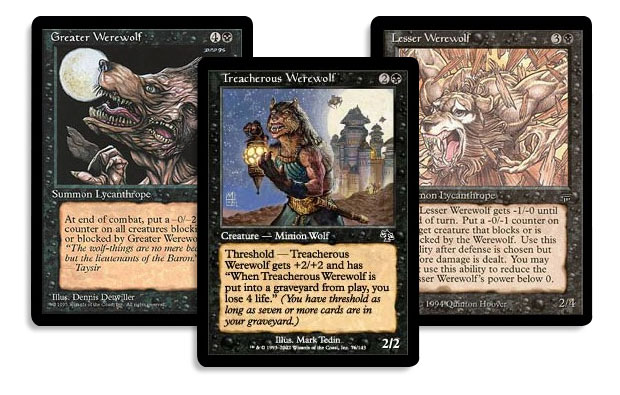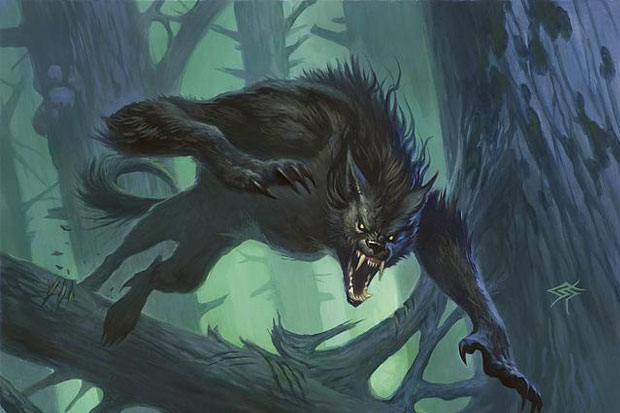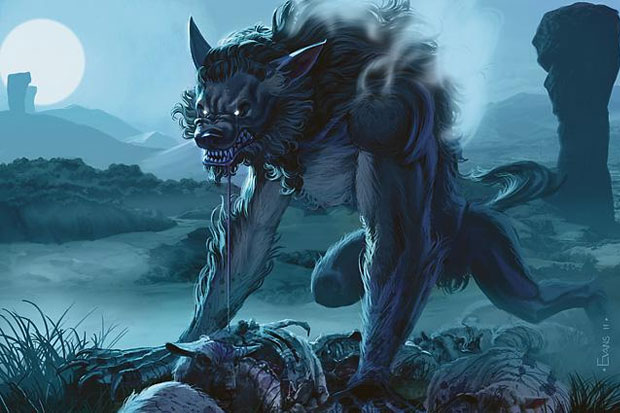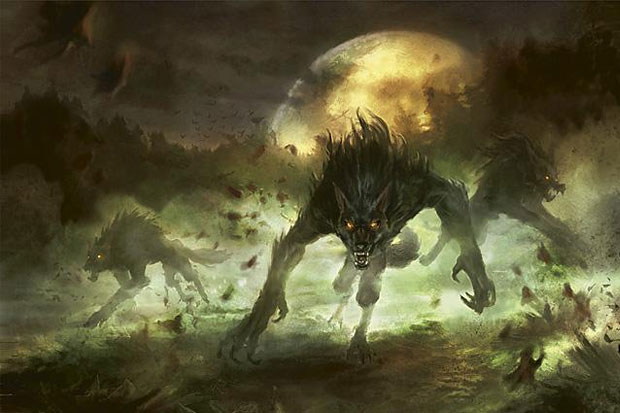Were the Wild Things Are
Welcome to Werewolf Week! This week we'll be
exploring what I believe is the pinnacle tribe in the
Innistrad design. Today I'm going to walk you through the history
of Werewolf design (it won't take long—there isn't much) and then explain
everything the design and development team went through to bring you the
Werewolves of Innistrad. Sound fun? Aaaaaaoooooooooooo. (That's me
trying to howl like a werewolf.) Let's go.
-
Big Bad Werewolf
Before I can talk about how Innistrad designed Werewolves, let's take a little time to show what has happened before.
Click here to see the past of Magic's Werewolves:

And done. There you go. Thanks for joining us on this tour.
Oh, you wanted a little more than that? Okay. Let's look through these one at a time. We begin with Lesser Werewolf.
The first Werewolf to show up was in the set Legends. Read the text carefully and see if you can get the flavor. Now that you've looked at it closely, do you get the flavor? Yeah, neither do I. It can make itself weaker to permanently weaken other creatures. I guess it's biting them. I honestly can't make heads and tails of the flavor of this mechanic. Even beyond the flavor disconnect, the card is neither good nor fun, and it's very confusing. If I had to grade this card on its design, I'd be kind and give it a D.
Next up we have Greater Werewolf:
Apparently there was a least one designer on the Homelands design team who liked Lesser Werewolf. (And really when you name something "Lesser _________," you're daring a future designer to follow it up.) The problem with Greater Werewolf is that it seemed beholden to Lesser Werewolf. First it matched the power/toughness with another 2/4. (Somebody forgot to look up the word "greater.") I'm not quite sure why "Werewolf" calls out for a 2/4. Why toughness double power? They're hard to kill? I don't get it.
The card then follows up on the "I fight you and now you're maimed" flavor from Lesser Werewolf. This card at least makes it happen every time and doesn't force you to spend mana and weaken itself to do it. The resulting counter is also -0/-2 rather than -0/-1. (Back in the day, we made all sorts of crazy counters. Don't believe me? Try taking a peek at Frankenstein's Monster from The Dark.) I still don't get the flavor, but mechanically the card is better, moving it up to a C. Probably the nicest thing I can say about this card is that it is an early precursor to the wither mechanic, which I'm a fan of.
The next two cards weren't actually Werewolves, but they were lycanthropes in flavor, so I'm including them for this history lesson.
Dirty Wererat and Werebear were both creatures from Odyssey. We decided to use threshold to represent transformation, and so we made two creatures that were lycanthropes (animals that turned into were-versions of themselves). Both cards captured the flavor of transformation and each definitely played a different role once it was changed. Design-wise, I'd give these a B. The biggest strike against them is the threshold mechanic itself, which turned out to be problematic in how it worked across the board. It's interesting that the best rated were-creatures in Magic's history aren't even Werewolves.
Now Odyssey block did manage to use threshold to make one actual Werewolf:
Treacherous Werewolf showed up in the last set of the block, Judgment. It had the transformation flavor using threshold, but the overall flavor beyond that was weak. Why exactly do you, the Planeswalker, lose 4 life when your creature dies in werewolf form? The disconnect is enough to drop the grade of this card down to a C.
So how did Werewolves fare historically? Two Cs and a D. You get to add in two Bs if you include all lycanthropes. Not exactly a solid standing. This is why coming into Innistrad design I knew we had a responsibility to do werewolves right.
-
Hungry Like the Werewolf
I've explained that from the first pitch of the idea of a world based on fantasy horror tropes to the execution, a lot of time went by (close to ten years, I believe). That means I had a lot of time to think about Innistrad, and as I did, I came to numerous conclusions about what the set would need to be. One of the conclusions was this: if the design was going to be a success, we had to find a way to design Werewolves. The key to making the whole thing work was making its jewel—and I considered this to be Werewolves, because every other key tribe we're doing has been done and done well sometime during Magic's history—shine. If Innistrad was going to work, we had to solve Werewolf design.

Merciless Predator | Art by Michael C. Hayes
Usually when I'm doing top-down design (that is, I'm designing mechanics to match flavor rather than starting with the mechanics), I start by writing down everything I know about the thing I'm designing. So, what does a werewolf have to do? Here's what I had:
#1 – A Werewolf Has to Have a Human State and a Werewolf State
To me, the most defining thing about werewolves is their dual nature. Unlike almost every other monster, they're not a monster full time. Most of the time, they're human. I felt it was important for the mechanic to capture this essential part of what defines them.
Note that this is my perspective. There are fantasy properties that have werewolves that are essentially werewolves all of the time. We could have simply made creatures that were werewolves and played up their feral nature rather than their transformation, but I felt like that was missing out on the core of what makes werewolves interesting.
#2 – The Werewolf Part Is Stronger Than the Human Part
Every monster has to have a vulnerability. In order for the humans fighting it to have a chance, there needs to be some Achilles's heel of the monsters. Werewolves have a very interesting weakness in that they are powerless in their human form. Yeah, it's very hard to kill a werewolf when he's a werewolf (silver bullets aside—see, another vulnerability), but not so much when he's just Joe, the guy next door.
#3 – The Change Is (Mostly) Out of Their Control
Another important part of werewolves is that they change not by their own choice but due to external circumstances. Yes, Twilight and other properties have broken this rule, making werewolves completely in control of their change, but I felt strongly that was fighting the essence of the horror-ness of werewolves. I want creatures that were out of control and scary. I wanted our werewolves to truly be monsters, and a key part of that is a lack of control.
#4 – The Trigger for the Change Is the Full Moon
If we're going to follow traditional werewolf lore, this was the flavor we had to reflect.
#5 – All Werewolves Change Together
If the full moon triggers the transformation, then when one infected human becomes a werewolf, all infected humans become werewolves.
#6 – The Werewolves Had to Have a Wildness to Them
Another big difference between werewolves and many other monsters is that the werewolves are mostly guided by instinct. In most werewolf stories, the human has very little control over the werewolf part of them. Often, they don't even remember what happens during the time they're a werewolf. I thought it was important to get this animalistic element of werewolves across.

Nightfall Predator | Art by Steve Prescott
Once I had all this written down, then I combed through my list and see what each thing meant mechanically.
#1 – A Werewolf Has to Have a Human State and a Werewolf State
Werewolf cards had to be creatures with two states. Magic has messed around in this space many times (threshold, flip cards, level-up, etc.).
#2 – The Werewolf Part Is Stronger Than the Human Part
For costing purposes this means that we want players to play Werewolves starting with their Human part. This allows us to make decently costed creatures that you have to jump through a hoop to upgrade. Luckily, the flavor of werewolves helps us want to start on the human side. We always tend to meet the human part of a werewolf first in a werewolf story.
#3 – The Change Is (Mostly) Out of Their Control
This means that the catalyst for the change needs to be external rather than internal—or, in other words, the player isn't going to be able to simply choose when his or her creature will change into a Werewolf. That said, I did want the Werewolf player to be able to influence the change.
#4 – The Trigger for the Change Is the Full Moon
There are two ways to accomplish this: blatantly and implied. As I talked about during preview weeks, we explored making a day/night mechanic, where at any point in the game it is defined whether the sun is out or the moon is out. That would be the blatant way of doing a full moon. The implied way is to create a change and allow players to fill in the full moon flavor themselves. We obviously went with the latter, but I'll talk more about this when we get to it.
#5 – All Werewolves Change Together
This meant that all the Werewolf cards needed to have the same trigger—not just yours, but everyone's.
#6 – The Werewolves Had to Have a Wildness to Them
This flavor is what got me to push for Werewolves in red and green, as those were the two colors that best captured this wild element of werewolves. It's interesting to note that all three previous Werewolves, and four out of the five previous lycanthropes, were black.
I often talk about how "restrictions breed creativity," and that was definitely the case for Werewolves. I had spelled out what we had to do. All that was left was to find a way to do it.
-
A Werewolf in Sheep's Clothing
The story of the Werewolves doesn't start with double-faced cards. In fact, you could say double-faced cards started with Werewolves. During one of our first design meetings, I talked about all the restrictions I explained above. The team agreed with me, and that led us to discuss how we could best mechanically capture the flavor of werewolves. This discussion in turn led us to wanting to use transformation as a core part of the design.

Gatstaf Howler | Art by Mark Evans
The team talked about multiple ways to capture transformation, but two ways clearly stood above the rest: double-faced cards and the day/night mechanic. (Again, this is explained in further detail in my column on the design of double-faced cards.) The road to the Werewolf mechanic began not down the design path of double-faced cards, but rather down the path of designing the day/night mechanic.
A quick aside before we continue. The Werewolf mechanic isn't keyworded or even named, but it's as much a part of the design as flashback, morbid, or even transform. In fact, having had a chance to play with the finished product numerous times, I'm more proud of the Werewolf mechanic than of any other mechanic in the set.
The big breakthrough I made with the day/night design was a double-sided day/night card that represented whether it was day or night. Instead of having to spell out how to determine day/night status, the cards merely had to get the day/night card into play, and then the card independently would track it.
The key to making a day/night card work was that it had to have a single track on it. Half the track was during day and half the track was during night. There would be some trigger that would cause the counter on the track to advance. When the counter got to the end of the track on one side of the card, it would flip over, thus changing the day/night status. All the cards that cared about day/night status, including all the Werewolves, would just have cards that tell you what the day state and night state are. (Note that there are many ways to do this. As we never got there, this part of the design never got discussed.)
First, the trigger needed to be a single thing to make it easy to track. Second, it had to happen somewhat frequently, as it's very easy to forget something that's seldom used. Third, it needed to be something either player could do. Part of keeping it out of a single player's control was allowing all players to influence it. Once I broke all this down, the answer seemed pretty clear: I needed to track spells being cast.
To help show demonstrate how this worked, let me show you the mock-up I made for playtest:
The card came into play with the counter on the first space. Whenever a spell was cast by either player, the counter advanced to the next space. When the counter advanced from the third space to the fourth space, the card flipped over, and then it was night. As I said above, the transformation cards would all explain their day state and their night state.
In the end, the day/night mechanic had a bunch of problems that sunk it: It was complicated, it was wordy, it required at times tracking something that didn't matter but could, etc. Using spell casting as a means to regulate the transformation, though, proved to be very interesting. It allowed interactivity in a way that was organic to the game. It gave both sides influence without giving either one total control.
I often talk about how important failure is to success. The popular myth is that ideas come full-formed at their creation, when in reality good ideas take a long time to build by combining data collected from many places. The day/night mechanic didn't make it into the set, but a key component of it would become the backbone for the Werewolf mechanic.
-
Castle Werewolfenstein
With the day/night mechanic out, we made the decision to go forward with double-faced cards. (Again, you can read more about that in my preview article.) That meant that we needed to figure out how double-faced Werewolves would work.
I started, as with all the problems listed above, by stating what I knew about the design. The Werewolf double-faced cards would have a Human side and a Werewolf side. Some trigger would change all Humans to Werewolves, and some other trigger would change all Werewolves to Humans. Why did the two triggers have to be different? Because I didn't want to have a bunch of Werewolves with half changing from Human to Werewolf and half changing from Werewolf to Human, all on the same trigger.
I liked the idea of using spells as a regulator, but casting spells had nothing particularly to do with day or night. The answer to this is that you can't get boxed in by flavor when doing top-down design. We had tried the day/night card, which was the closest to that flavor that we could get. Barring something representing the sun and the moon, there really isn't any way for design to directly represent it.
I've learned long ago, though, that the key to flavor is not always hitting the nail on the head. Sometimes the best way to create flavor is to get out of the way. For example, the idea of a full moon is so strong in the flavor of werewolves that if the game state changes them and doesn't hint at any other flavor, players are going to naturally want to fill in the flavor of the moon. My attitude was to hit every other flavor note and not make the triggers represent anything mechanically. I felt casting spells worked well because it's a natural part of the game, which made it easy to blend in and allow the player to fill in the moon flavor.

Bane of Hanweir | Art by Wayne Reynolds
The next step was figuring out how exactly to use spell casting as a trigger. I needed one trigger for Human-to-Werewolf and another one for Werewolf-to-Human. For the Human-to-Werewolf trigger I wanted something that the controller of the Werewolf had access to but that his or her opponent(s) could try to stop. No spells being cast hit the exact thing I was looking for.
The controller of the Werewolves could always attempt to transform them by choosing not to play any spells for a turn. This wouldn't be guaranteed, though, because an opponent could cast an instant during that player's turn. Also, the Werewolf would put pressure on the opponent. Once one was on the battlefield, the opponent had to make sure to cast a spell each turn. Playtesting showed that this created the right amount of tension.
The trigger to transform back was a little harder. I wanted it to be something that the opponent could do, but not easily. Casting two spells on a single turn worked great. First, it was something that the opponent couldn't continually do, meaning the inertia would push the Werewolves to eventually stay Werewolves. Second, it had a nice play with the strategy of stopping the transformation in the first place. How do you fight the Werewolves—cast a spell each turn to stop them from ever becoming Werewolves, or cast two spells each time they transform to transform them back? You can't do both. Third, I liked that having a Werewolf (or Werewolves) created a handicap for the Werewolf player, who now couldn't cast more than one spell a turn or the Werewolf would transform back.
The no-spell / two-spell triggers were the very first ones we tried and worked wonderfully. There were two changes along the way, though, both made in development by Erik Lauer and his team. First, the trigger originally happened at the end of the turn. The problem with this was that players could, for example, trigger a Werewolf by playing no spells that turn and then, when the trigger was on the stack, play instants. Worse, Werewolves would get into a fight and would then die at the end of the turn when they changed back into Humans and suddenly had a lower toughness. Development realized that both of these situations were problems, which was easily solved by moving the trigger from the end of the controller's turn to the start of the next turn.
The second change made during development was the shift from two spells being cast to two spells being cast by the same player. During design, all that was needed to transform a Werewolf was having two spells cast in the turn, even if one was cast by you and one by your opponent. This version created odd tension where a player with a Werewolf didn't want to cast any spells for fear that an opponent could cast one spell and transform the Werewolf back.

As I talked about when I discussed Werewolves during preview weeks, originally the human side was only a Human and the Werewolf side was only a Werewolf. This created some interesting interactions with the pro- and anti-monster cards. I remember numerous games in which I had Slayer of the Wicked or Victim of Night in hand and had to wait for the right side to come up. In the end, we put "Werewolf" on both sides of the creatures to allow cards that wanted to interact with them in zones where they couldn't "see" the backside to still interact with Werewolves. The flavor of the decision is that a werewolf always has some werewolf in it, even when in human form.
-
Back and Front
Once we knew how Werewolves were going to work, the next step was designing them. Because the werewolf mechanic unto itself is pretty complex, we decided to keep all the common Werewolves vanilla or French vanilla (Ramp;D speak for now abilities or just creature keyword abilities). In design, we made all the common Werewolves double in power and toughness when they transformed to make it easy to remember how big your Humans would become. These numbers ended up not working when development adjusted the power level, so that little memory aid went away, but you can still see it on some of the common Werewolves.
Another quick aside. I've had numerous players question me why most of the common Werewolves are "only vanilla." My answer is that the Werewolves are pretty complex. The reason we mostly kept them to just power and toughness stats was to take what was a very complicated mechanic and simplify it as much as we could at the lowest rarity.
For the higher-rarity Werewolves, the trick was to find a way to connect the two sides. The werewolf side was supposed to feel connected to the human side, but pumped up. Kruin Outlaw, for example, is a Human with first strike that turns into a Werewolf with double strike. Instigator Gang grants +1/+0 to all attackers and transforms into Wildblood Pack, which grants +3/+0 to all your attackers.
The final piece to the Werewolf puzzle was creating cards that enable and fight with the Werewolves. The Werewolf enablers fall into two camps. First are the cards that specifically aid Werewolves, such as Moonmist and Full Moon's Rise.
Second are the cards that allow you to spend mana during your turn to let you turn your Humans to Werewolves without wasting your mana. For instance, while the Equipment in the set plays well with many other aspects of the design, it works particularly well in a Werewolf deck. In each category, design created some cards, but development realized that our numbers were too low and added other cards in.
The cards created to fight the Werewolves are either instant or cheap. The first is to keep Humans from becoming Werewolves (when their controller tries to transform them on his or her own turn by not casting spells), and the second is to make it easier to turn them back.
-
Werewolf? There Wolf
That's about all the time we have for today. I hope you learned a lot about how the werewolves got turned into cards.
Join me next week when I answer some unanswered question about Innistrad.




